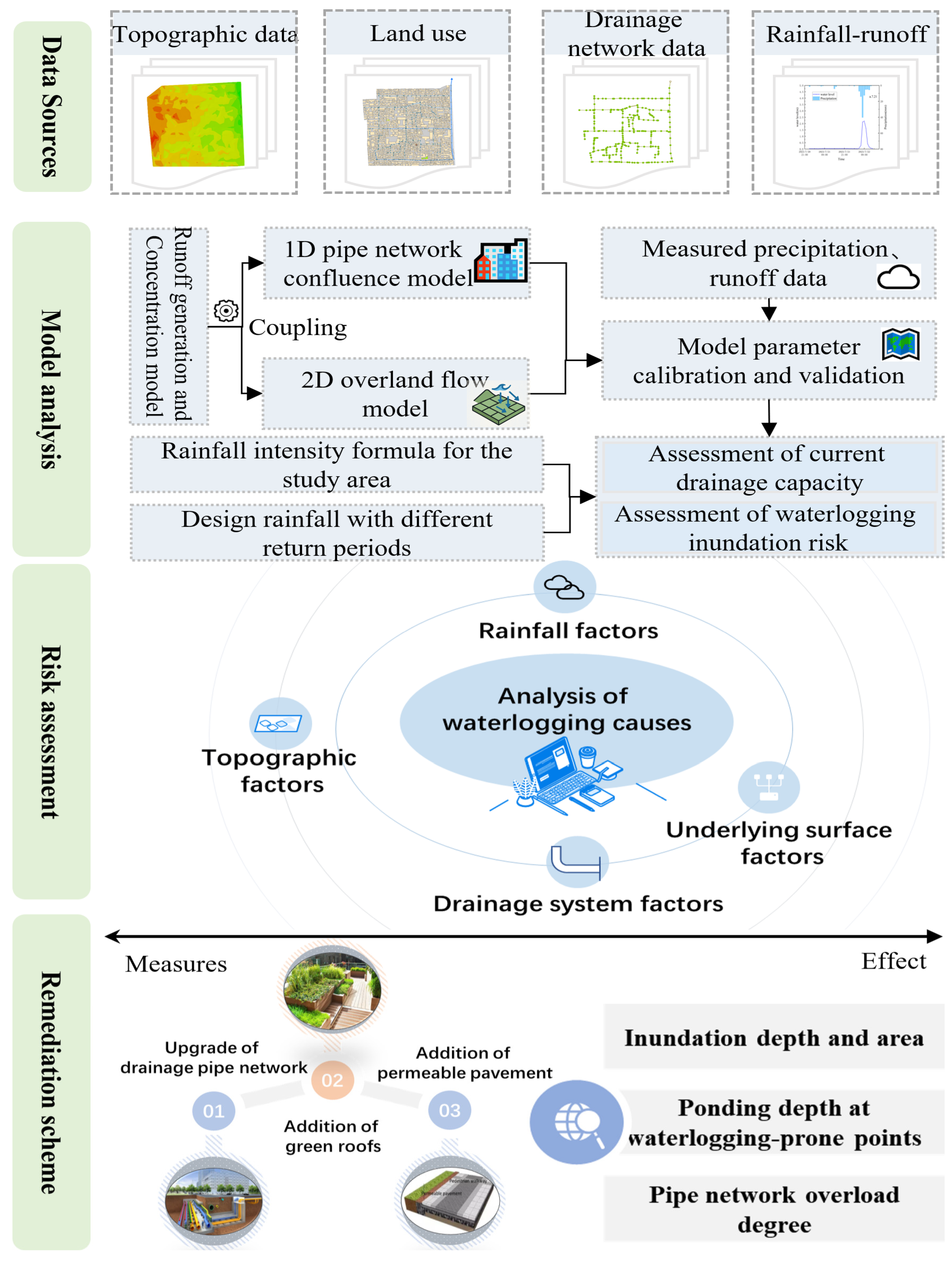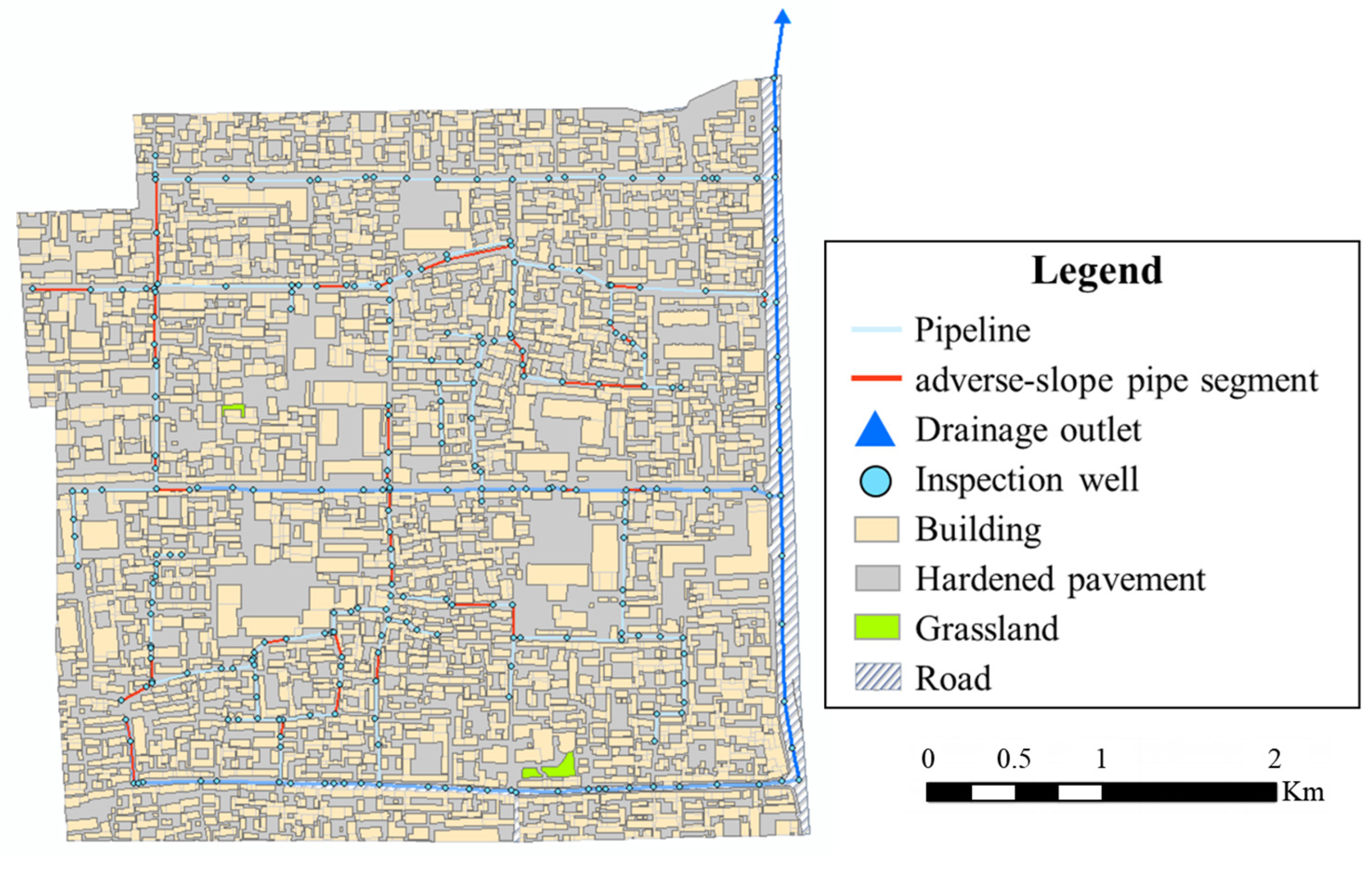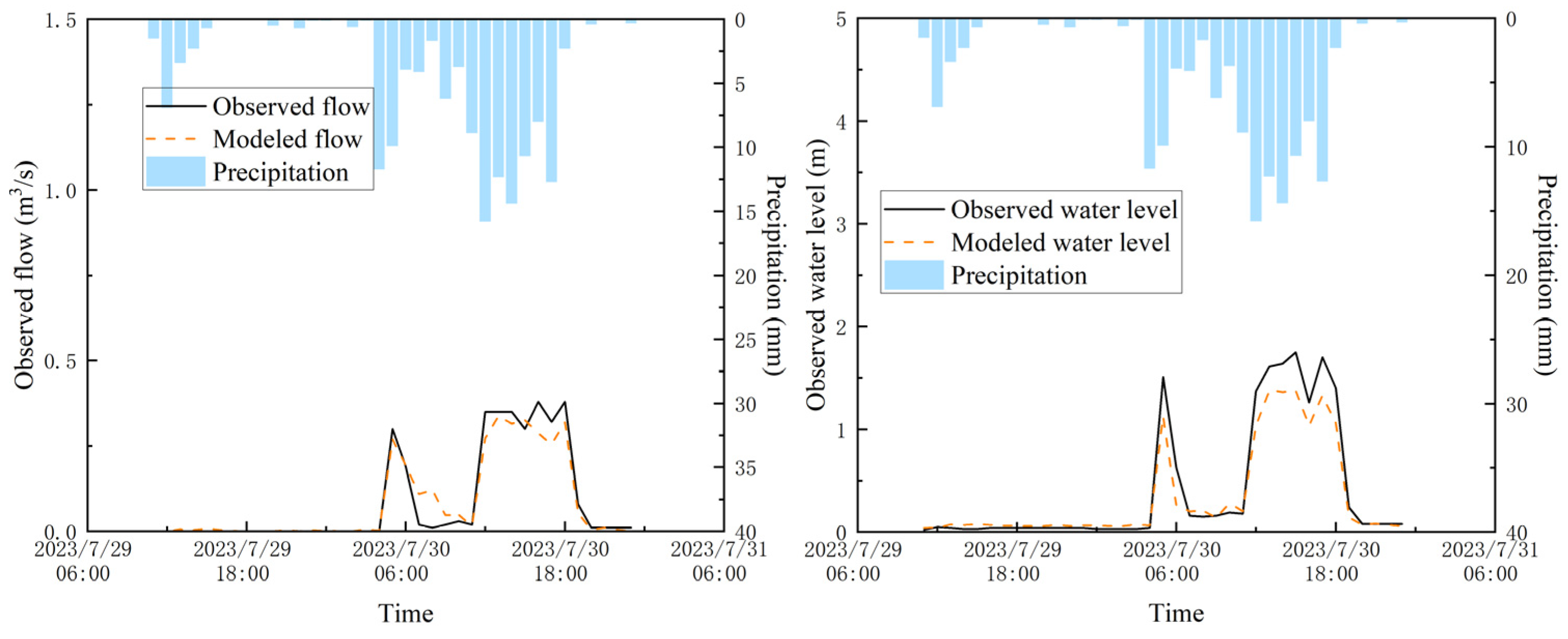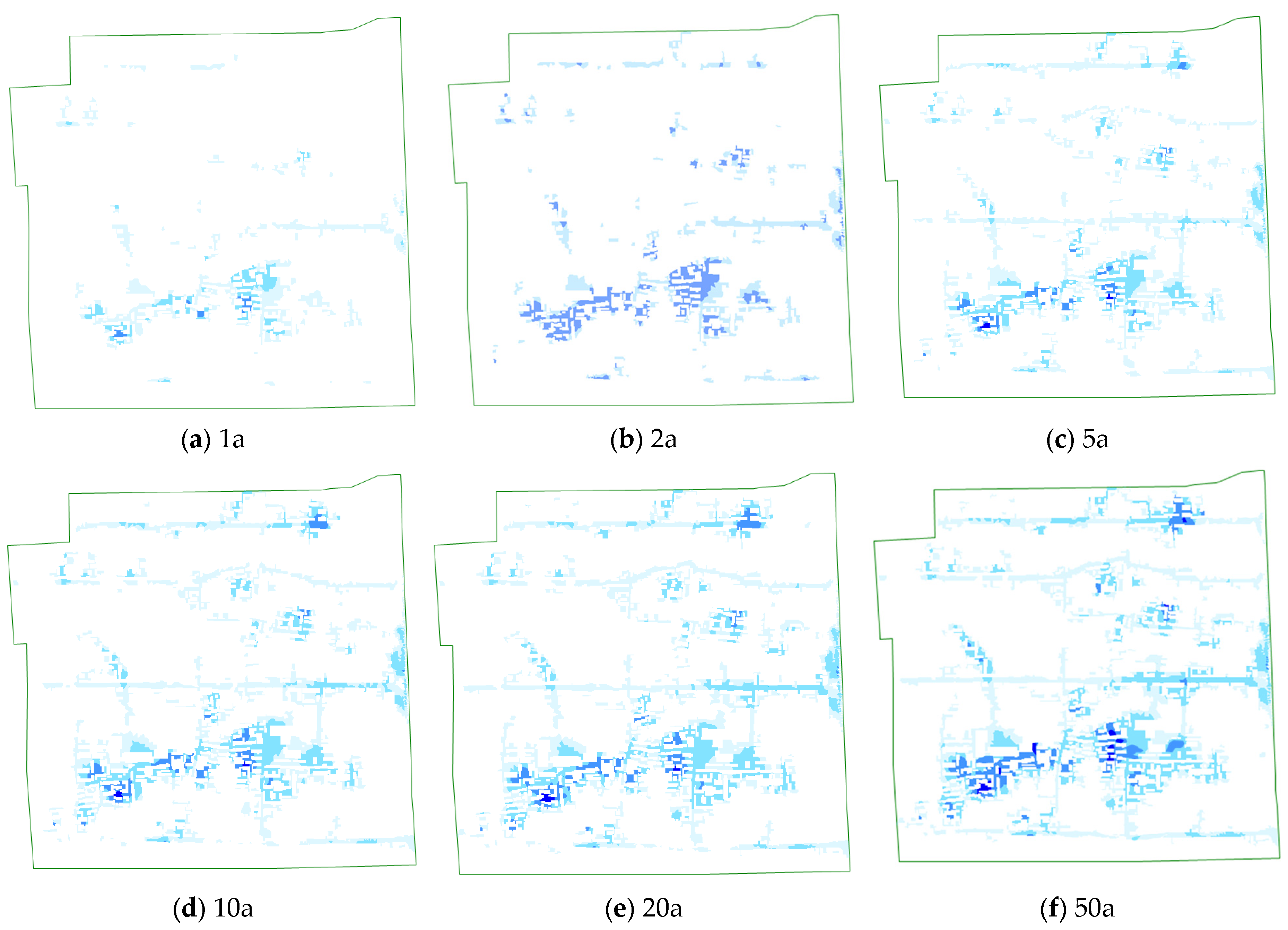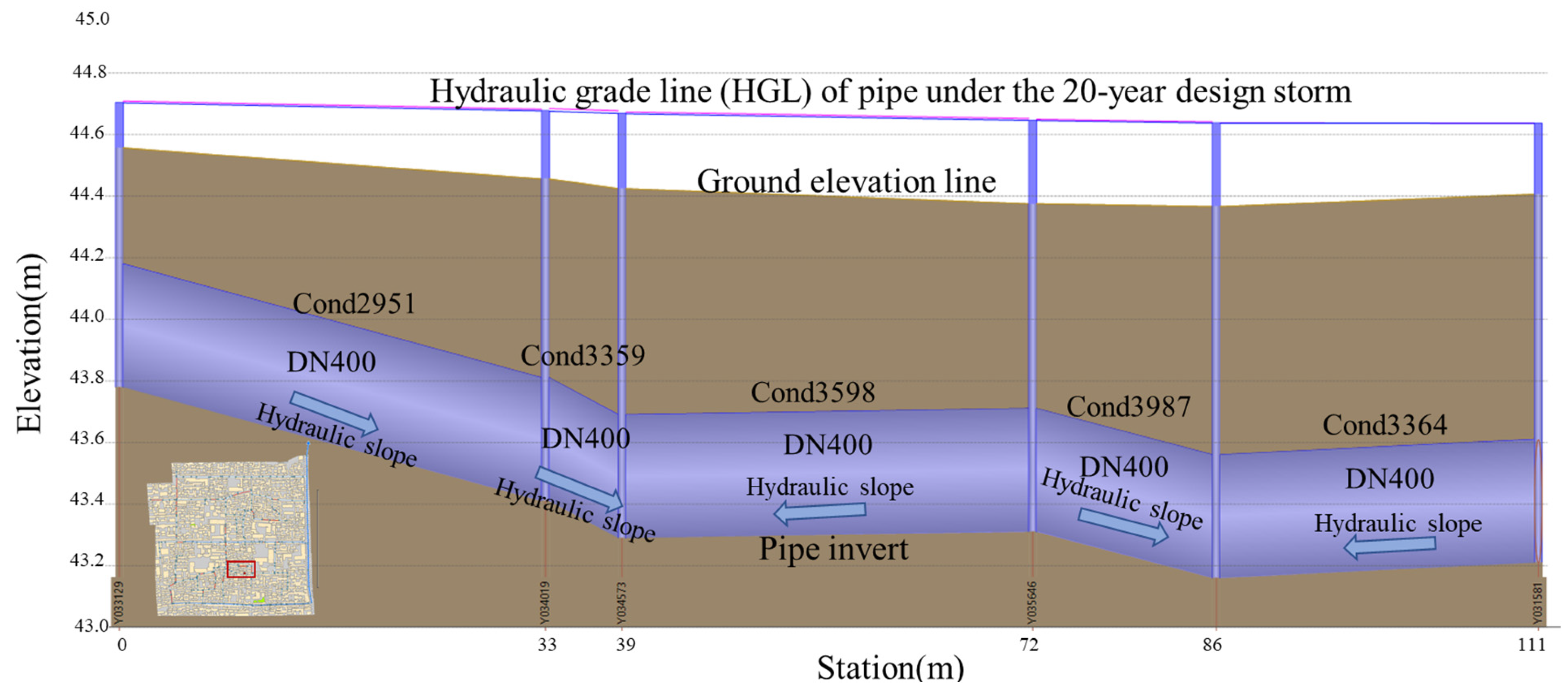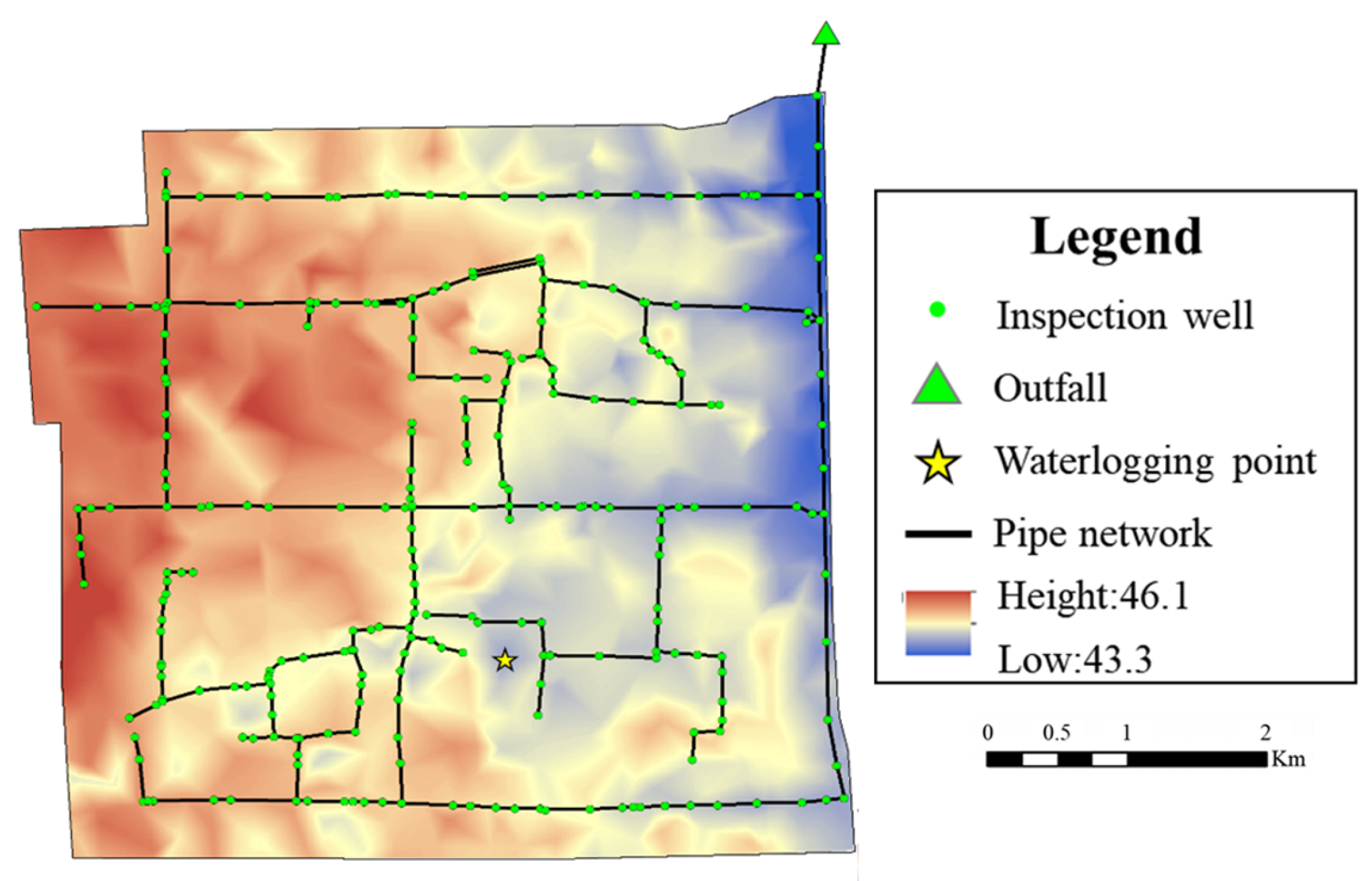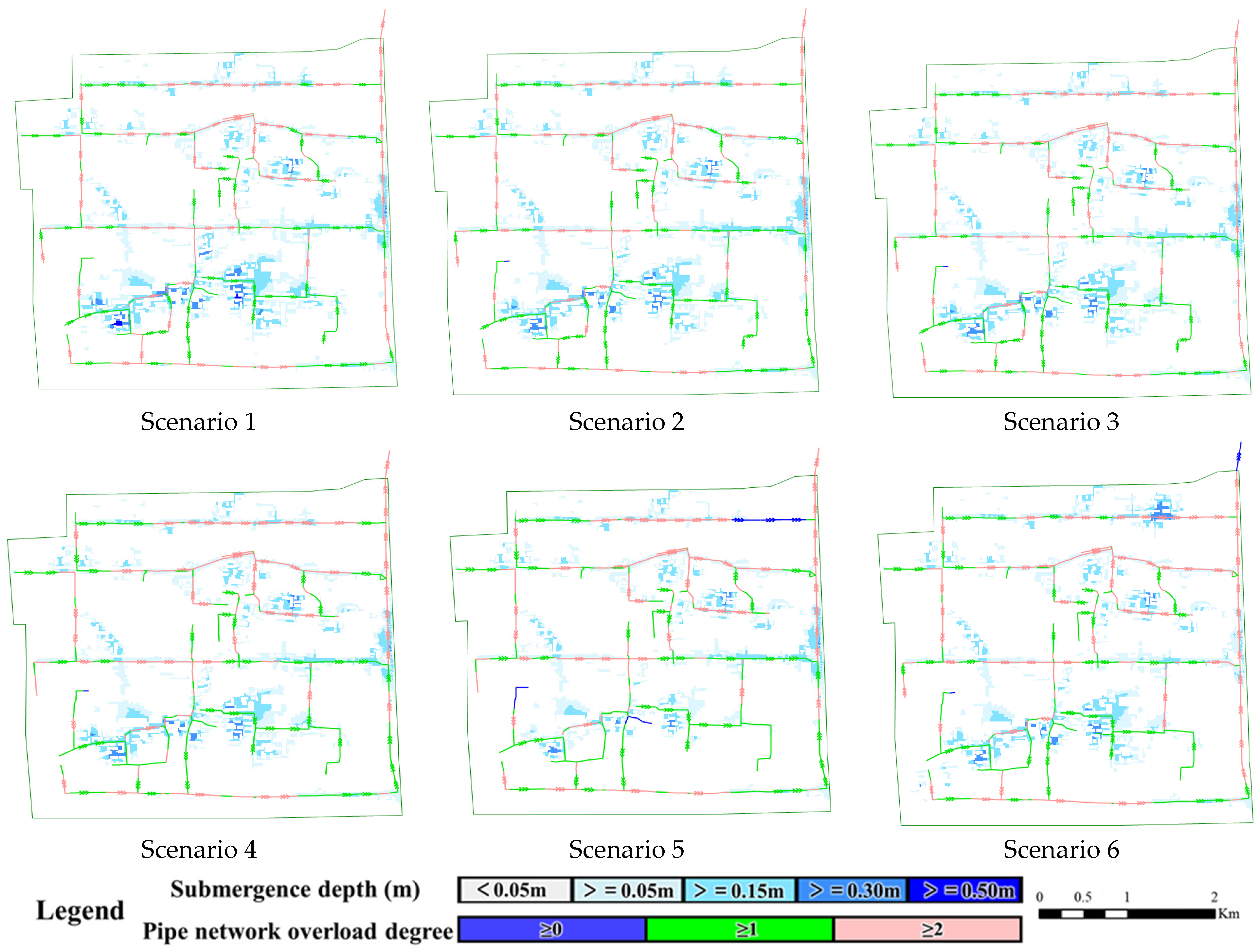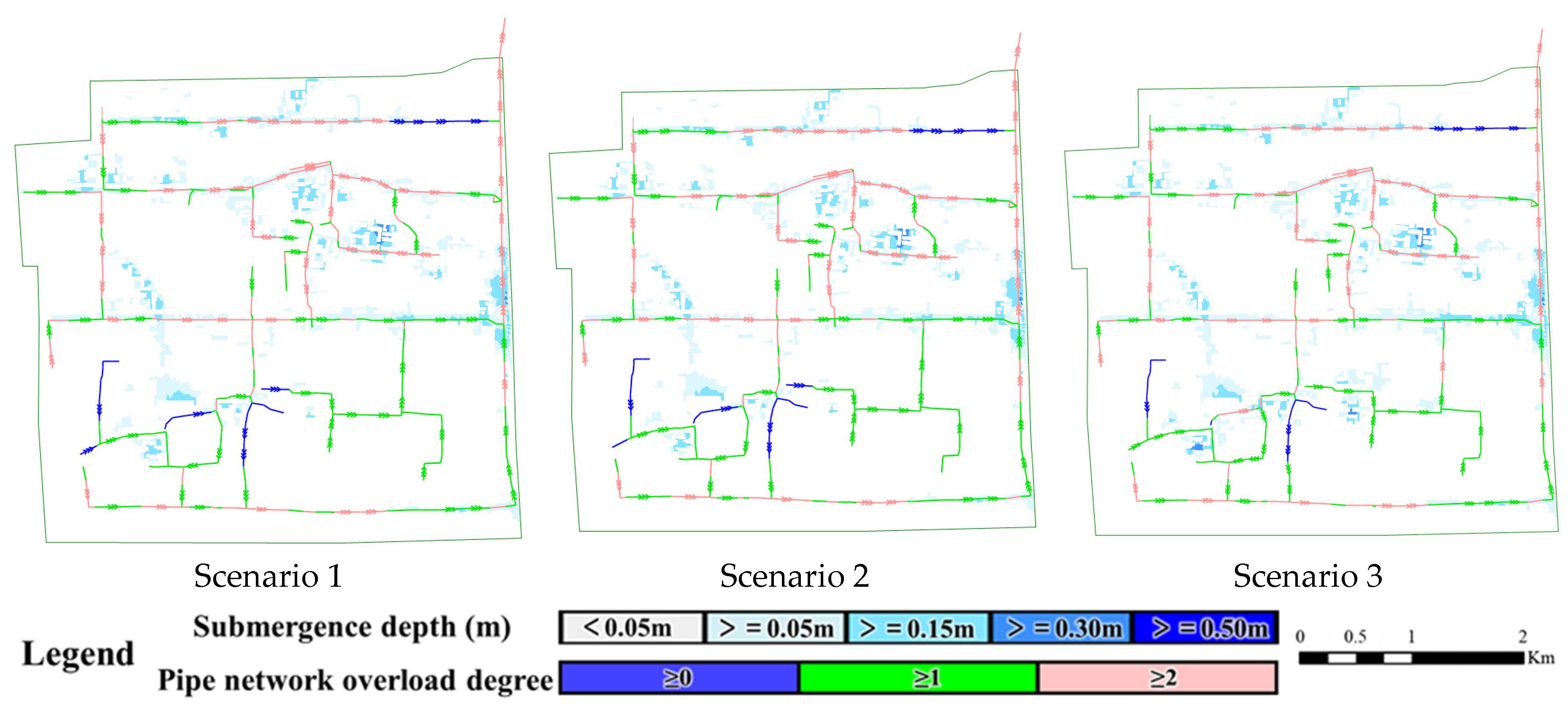4.1. Evaluation of Drainage Capacity of the Pipe Network
- (1)
Evaluation Based on Pipe Flow Capacity
In the assessment of drainage system performance, hydraulic diagnosis is carried out by identifying overload conditions within the pipe network. The term overload condition refers to the operational status of the drainage pipes, which can generally be classified into the following three categories (
Table 4):
As shown in
Table 5, the drainage performance of the current pipe network declines with increasing design return periods. Under the 1-year return period, approximately 43% of the total pipeline length (2268.1 m) operates under fully filled conditions, and 56.6% (2999.4 m) is already overloaded. When the return period increases to 2 years, all under-capacity segments disappear, and the proportion of overloaded pipes rises to 58.6%. This trend continues as the return period increases: by the 50-year return period, 65.7% of the network (3483.2 m) is overloaded, while only 34.3% (1815.1 m) operates at full capacity.
These results indicate that the existing stormwater drainage system lacks sufficient resilience to handle medium to high return period rainfall events, with a large proportion of the network entering pressure flow or surcharge states even under relatively frequent (2–5 year) storms. Upgrading critical pipe sections is necessary to meet long-term urban flood mitigation demands.
- (2)
Evaluation Based on Node Overflow Method
In some cases, it is necessary to adjust the criteria for determining whether the drainage capacity of a pipe has been exceeded. This is because stormwater pipes are typically buried at considerable depths, and the water level can rise above the pipe crown without immediately causing surface flooding, due to the remaining available headspace between the pipe crown and ground level.
A filling degree threshold of 1 may therefore be too conservative. If pressure flow within the pipe is permitted, the occurrence of overflow at manholes can be used as an alternative indicator. In this approach, a pipe is considered hydraulically overloaded if the hydraulic grade line (HGL) exceeds the ground elevation at a manhole. The corresponding overload criterion can be expressed as follows:
In the equation: H represents the hydraulic head at the manhole node (m), and W is the ground elevation at that location. If the result δ ≤ 0, it indicates that the pipe’s drainage capacity meets the requirements of the corresponding design return period. Conversely, if δ > 0, the pipe is considered hydraulically insufficient under that return period.
The assessment results are shown in
Figure 12. Approximately 46.9% of the drainage pipes in the study area meet or exceed the capacity required for a 1-year return period, representing the current compliance rate of the system. Among these, 25.9% of the pipes meet or exceed the 2-year standard, 16.6% meet or exceed the 5-year standard, and only 12.8% exceed the 5-year threshold (
Table 6). These findings indicate that the drainage capacity of the existing network gradually decreases with increasing return periods, highlighting the system’s limited ability to cope with more extreme rainfall events.
4.2. Urban Waterlogging Inundation Risk Assessment
Using the calibrated 1D pipe–2D surface coupled hydrodynamic model, inundation processes under design rainfall events with return periods of 1, 2, 5, 10, 20, and 50 years were simulated. Inundation depth maps were generated for each scenario, and the variations in maximum water depth were statistically analyzed and compared.
The classification of inundation risk levels is presented in
Table 7. Detailed inundation simulation results under different return periods are shown in
Figure 13 and
Table 8 and
Table 9.
As shown in
Figure 13, both inundation depth and inundation area increase with the rise in rainfall return period. Combined with the data in
Table 9 and
Table 10, it is evident that under different rainfall scenarios, the study area exhibits a progressively intensifying trend in inundation severity as rainfall intensity increases. When the return periods are 1 year and 2 years, the maximum water depths are 0.45 m and 0.49 m, respectively, with corresponding inundation areas of 0.0042 km
2 and 0.0100 km
2. In both cases, inundation is mainly confined to low-risk zones (0.0037 km
2 and 0.0090 km
2, respectively), with only a small proportion of medium-risk areas and no high-risk areas. Once the return period exceeds 2 years, high-risk inundation zones begin to emerge. Under the 5-year return period scenario, the maximum water depth increases to 0.53 m, and the total inundation area reaches 0.0197 km
2, including a high-risk zone of 0.0001 km
2. As the return period further increases, the extent of high-risk areas grows steadily. By the 50-year event, the maximum inundation depth reaches 0.79 m, and the total inundated area expands to 0.0435 km
2, with high-risk zones accounting for 0.0041 km
2—nearly 10% of the total (
Figure 14).
In summary, the overall flood risk in the study area is manageable under low- to moderate-intensity rainfall events, with a critical threshold observed between the 2-year and 5-year return periods. As rainfall intensity continues to increase, more attention should be given to emergency response and drainage improvement in high-risk areas.
4.3. Analysis of Waterlogging Causes
To quantitatively analyze the causes of waterlogging at specific locations, key factors such as regional drainage capacity, topographic characteristics, and underlying surface conditions were considered.
- (1)
Drainage System Factors
For the waterlogging point under investigation, the upstream drainage pipes connected to the associated catch basin were examined. Relevant design specifications and pipe dimensions were collected, along with data on their designed flow capacities. The cross-sectional flow capacity of the drainage pipes can be calculated using the Manning formula or the Chezy formula.
In the equation: is the flow capacity of the pipe section, in m3/s; K is the flow modulus, in m3/s; J is the hydraulic gradient; d is the pipe diameter, in m; n is the roughness coefficient, taking the value of 0.015.
It is evident that the designed flow capacity of the downstream pipes near the waterlogging point is insufficient. For example, the design discharge capacities of pipe segments Cond2551 and Cond3987 are only 0.1890 m
3/s and 0.1842 m
3/s (
Table 10). This limited capacity prevents stormwater from being discharged in a timely manner into the main trunk system, resulting in a hydraulic backwater (surcharge) effect.
In addition, an analysis of the pipe slope distribution in the vicinity of the waterlogging point reveals two pipe segments with adverse slopes in the downstream section (see
Figure 15), which further hinder drainage and cause significant upstream water level rise and surface ponding.
According to the drainage capacity distribution map based on node overflow (
Figure 12), all nearby pipe segments around the waterlogging point are below the 1-year return period standard. The combined effects of backwater from downstream, adverse slopes, and insufficient pipe capacity exacerbate local water accumulation at the waterlogging point.
- (2)
Topographic Factors
The topographic map of the study area is shown in
Figure 16. The waterlogging point is located at a local depression within the area, with an elevation of 44.041 m. The surrounding terrain is relatively higher, with elevations exceeding 44.3 m, resulting in a local elevation difference of approximately 0.25 m forming a basin-like low-lying area.
In terms of drainage infrastructure, the top elevations of manholes surrounding the waterlogging point range from 44.34 m to 44.79 m, all situated on relatively higher ground around the point. During heavy rainfall events, stormwater at the waterlogging point is unable to flow into the higher-elevation manholes, limiting effective collection and discharge. As the contributing catchment area and local elevation gradient increase, water accumulates more rapidly and extensively in the lower-lying zone.
- (3)
Underlying Surface Factors
The area around the waterlogging point is primarily composed of buildings (accounting for 50%) and impervious pavement (accounting for 47%). The runoff coefficient for these land use types ranges from 0.85 to 0.95. Due to the large proportion of impervious surfaces, short rainfall duration, and limited evaporation losses, the area exhibits high runoff coefficients, rapid runoff generation, and fast concentration processes. As a result, peak flow rates are high, making it easier for water to accumulate in local depressions and cause waterlogging.
- (4)
Rainfall Factors
Short-duration intense rainfall is a key driver of urban waterlogging. The drainage infrastructure in the vicinity of the waterlogging point is designed for no more than a 1-year return period, which corresponds to a design rainfall intensity of approximately 15 mm/h. When actual rainfall intensity exceeds this threshold, waterlogging is likely to occur. According to inundation simulation results, under the 50-year return period scenario, the inundation area and maximum depth increased by 925.5% and 175.6%, respectively, compared to the 1-year scenario. Therefore, excessive rainfall is another critical factor contributing to severe urban waterlogging.
Based on the surcharge ratios of the drainage network across different return periods, the node-overflow capacity grading, and the hydraulic diagnosis at inundation hotspots, it is evident that once the design storm exceeds the 2-year level, more than 50% of the pipe network becomes surcharged (
Table 5), with local adverse slopes further aggravating backwater effects. Therefore, insufficient drainage capacity is identified as the primary driver of waterlogging in the study area. In addition, the inundation hotspot is located within a local depression about 0.25 m lower than the surrounding terrain (
Figure 16), and nearby manhole inverts are generally higher than the ponding point, making it difficult for stormwater to enter the pipe system; thus, topographic depressions serve as a secondary but critical limiting factor. Meanwhile, the land surface is dominated by buildings and paved areas, with an imperviousness ratio of 97% (
Table 1). Under short-duration, high-intensity rainfall events, this configuration produces high runoff coefficients and rapid concentration, thereby amplifying peak inflows and delaying water recession. Simulation results indicate that medium-risk zones emerge between the 2- and 5-year storms, while high-risk zones appear in the 10–20-year events and then expand progressively under more extreme return periods. Given that the current model does not allow independent perturbation of the four drivers, this study provides an evidence-based prioritization rather than quantitative shares, and states that future work will employ sensitivity analysis and multi-scenario simulations to achieve quantitative attribution.
4.4. Optimization of Urban Waterlogging Mitigation Measures
In response to the deficiencies of the aging drainage network, such as low design standards and reverse slopes, a zoned pipeline renovation strategy was proposed. To systematically test its effectiveness, six scenarios were designed with varying levels of pipeline optimization. Considering the limited land resources and dense built environment in the study area, traditional flood control measures such as retention tanks, infiltration ditches, or detention zones were deemed infeasible. Therefore, we focused on more practical grey–green retrofit solutions. Specifically, three scenarios combined pipeline optimization with different coverage levels of green roofs, while another three scenarios combined pipeline optimization with permeable pavements. In total, 12 scenarios were established to evaluate both single and combined measures at different implementation scales. The detailed configuration is summarized in
Table 11.
In this section, the analysis of waterlogging causes considers multiple mitigation scenarios, including pipe optimization alone, pipe optimization combined with green roofs, and pipe optimization combined with permeable pavements. The cost parameters are derived from local data and the unit cost information of low impact development (LID) facilities provided in the Technical Guide for Sponge City Construction [
37], encompassing both construction and operation–maintenance costs [
38,
39].
- (1)
Pipe Network Optimization Strategy
Based on the assessment of drainage capacity in the study area, an optimization plan was developed to address the deficiencies in the existing pipe network. The principles guiding the pipe network retrofit strategy are summarized as follows:
The design is based on the current model evaluation results, aiming to fully utilize existing pipe sections that already meet the discharge standards, and to avoid unnecessary demolition or reconstruction.
The current pipe layout should be preserved as much as possible to minimize excavation and construction work.
If the above strategies fail to achieve the target performance, the addition of new pipelines may be considered.
Engineering Constraints:
Modifications are limited to upgrades of the existing system, such as increasing pipe diameters or extending pipe sections.
No “large-to-small” pipe connections are allowed; that is, the diameter of downstream pipes must not be smaller than that of upstream pipes.
The diameter difference between adjacent pipe segments must not exceed 500 mm.
Pipes must remain buried below ground level, and reverse slopes are not permitted.
The drainage network was divided into eight functional zones: Trunk Line 1, Trunk Line 2, Main Line 1, Main Line 2, Main Line 3, Q1, Q2, and Q3 (see
Figure 17). Six retrofitting scenarios were developed for these zones. The pipe lengths and corresponding estimated construction costs for each scenario are presented in
Table 12. The upgraded pipe lengths for the six scenarios are 2315.9 m, 2315.9 m, 2686.7 m, 2907.1 m, 2649.2 m, and 2204.0 m, with estimated costs of 653,000 yuan, 714,000 yuan, 847,000 yuan, 927,000 yuan, 950,000 yuan, and 683,000 yuan, respectively.
To evaluate the effectiveness of different pipe network retrofit strategies in mitigating urban waterlogging, six scenarios were compared based on simulated results of maximum water depth, inundation area, and risk level distribution. The simulation results under different scenarios are presented in
Table 13 and
Table 14 and
Figure 18. The results show that as the intensity of pipe upgrades increases, both the water depth and inundation extent decrease significantly, while overall inundation risk is effectively reduced.
Scenario 1, representing the minimal intervention scheme, resulted in a maximum water depth of 0.50 m and an inundation area of 0.0155 km2, with high-risk zones still present—indicating limited mitigation effect. Scenarios 2 through 4 progressively expanded pipe diameters and upgrade areas, reducing maximum water depth to 0.46 m and stabilizing inundation area around 0.0129 km2. Although high-risk areas were eliminated, the marginal benefits of additional investment gradually diminished. Scenario 5 adopted large-diameter replacements for most trunk lines, achieving the most significant improvements: the maximum water depth dropped to 0.37 m, and the inundation area shrank to 0.0086 km2. It exhibited the smallest combined area of low- and medium-risk zones and completely eliminated high-risk zones, demonstrating the best overall control performance. Scenario 6 introduced new pipe segments and optimized layout under cost constraints, achieving favorable outcomes with a maximum water depth of 0.45 m and an inundation area of 0.0118 km2—better than Scenarios 2 and 3, but slightly less effective than Scenario 5.
Considering both mitigation effectiveness and construction cost, Scenario 5, despite having a relatively higher cost (approximately 950,000 yuan), provides the most substantial flood alleviation effect and is therefore recommended as the optimal solution in this study.
- (2)
Combined Pipe Optimization and Green Roof Strategy
While the application of individual measures can alleviate waterlogging to some extent, localized inundation still occurs in the study area, with the maximum water depth at critical waterlogging points exceeding 0.15 m. In addition, implementing a single mitigation measure alone tends to result in high construction costs. To further enhance the effectiveness of urban waterlogging mitigation in old districts, three combined scenarios were designed by integrating different scales of green roof installations on top of the optimized pipe network configuration. A comparative analysis was conducted to assess their drainage performance and cost-effectiveness.
Therefore, this study proposes a combined mitigation approach, integrating the most effective pipe optimization scenario with green roof measures. Three combined strategies were designed as follows:
Scenario 1: A total green roof area of 732.8 m2 was installed at the waterlogging point, accounting for 0.23% of the total study area. The green roof construction cost was 732,800 yuan, and the pipe retrofit cost was 949,700 yuan, resulting in a total investment of 1,682,500 yuan. Under this scenario, the maximum water depth at the waterlogging point was reduced to 0.15 m.
Scenario 2: Building on Scenario 1, the green roof coverage was further increased to 899.6 m2 (0.29% of the study area). The green roof cost was 899,600 yuan, and the total cost including the pipe upgrade remained at 1,849,300 yuan. The maximum water depth at the waterlogging point remained at 0.15 m.
Scenario 3: A smaller green roof area of 366.4 m2 (0.12% of the study area) was implemented based on the same pipe optimization scheme. The green roof cost was 366,400 yuan, and the total cost was reduced to 1,316,100 yuan. However, the maximum water depth at the waterlogging point increased to 0.29 m.
The simulation results under different scenarios are presented in
Figure 19,
Table 15 and
Table 16. Simulation results indicate that Scenario 1 reduced the maximum water depth at the critical waterlogging point to 0.15 m, with an inundation area of 0.0056 km
2. Only a negligible medium-risk area (0.0002 km
2) remained, and high-risk zones were entirely eliminated. Although Scenario 2 increased the green roof area by 22.76% and the total construction cost by 9.92% compared to Scenario 1, it did not yield further significant improvements—the maximum inundation depth, area, and risk level distribution remained unchanged. In contrast, Scenario 3 reduced the green roof area by 50% and the total cost by approximately 21.78%, but this led to a rebound in maximum water depth to 0.29 m and an expansion of the inundation area to 0.0069 km
2, with larger low- and medium-risk zones.
Overall, Scenario 1 stands out as an effective integration of green infrastructure and traditional grey engineering. It significantly reduces flood risk while keeping costs under control. Scenario 2, despite higher input, exhibits diminishing marginal returns and lower cost-efficiency. Scenario 3, although more economical, shows a marked decline in mitigation performance. Therefore, Scenario 1 is recommended as the optimal integrated mitigation scheme, balancing hydraulic performance and economic viability, and providing a practical solution for flood control in aging urban districts.
- (3)
Combined Pipe Optimization and Permeable Pavement Strategy
Building upon the most effective pipe optimization scheme, this study further introduces permeable pavement measures to enhance waterlogging mitigation in the study area. Three combined scenarios were developed, as detailed below:
Scenario 1: A total of 783.1 m2 of permeable pavement was installed in the old urban district, accounting for 0.25% of the study area. The construction cost for the permeable pavement was 313,200 yuan, and the pipe retrofit cost was 949,700 yuan, resulting in a total cost of 1,262,900 yuan. Under this configuration, the maximum water depth at the waterlogging point was 0.33 m.
Scenario 2: An expanded permeable pavement area of 6215 m2 (2.00% of the study area) was implemented. The construction cost of the pavement reached 2,486,000 yuan, and combined with the pipe upgrade cost, the total investment was 3,435,700 yuan. This scenario completely eliminated water accumulation at the waterlogging point.
Scenario 3: A moderate permeable pavement area of 3968 m2 (1.28% of the study area) was installed. The pavement cost was 1,587,200 yuan, and with the pipe upgrade included, the total cost amounted to 2,536,900 yuan. Similar to Scenario 2, no waterlogging occurred at the critical point.
The simulation results under different scenarios are presented in
Figure 20 and
Table 17. Overall, Scenario I had the lowest cost but offered limited drainage performance, with notable residual ponding and risk zones. Scenario 2 demonstrated the most effective flood mitigation but incurred a significantly higher cost with diminishing marginal returns. Scenario 3 also achieved zero ponding at the key waterlogging point while reducing the total cost by 36.7% compared to Scenario 2, though it resulted in a slightly larger inundation area and higher risk level. Under budget-constrained conditions, Scenario 3 presents a practical and efficient solution, making it the recommended permeable pavement combination scheme for effective urban waterlogging mitigation in old urban districts.


